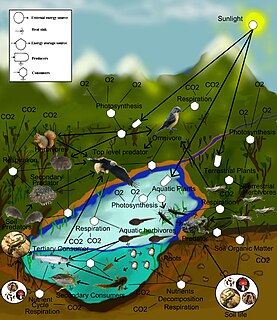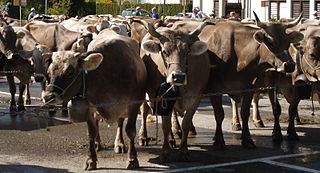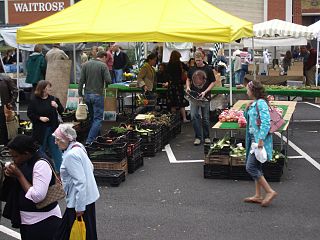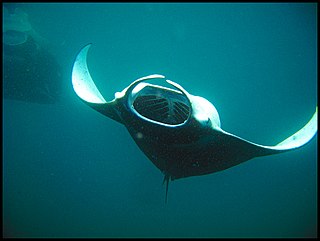 W
WEcology is the study of the relationships between living organisms, including humans, and their physical environment. Ecology considers organisms at the individual, population, community, ecosystems, and biosphere level. Ecology overlaps with the closely related sciences of biogeography, evolutionary biology, genetics, ethology and natural history. Ecology is a branch of biology, and it is not synonymous with environmentalism.
 W
WIn ecology, local abundance is the relative representation of a species in a particular ecosystem. It is usually measured as the number of individuals found per sample. The ratio of abundance of one species to one or multiple other species living in an ecosystem is referred to as relative species abundances. Both indicators are relevant for computing biodiversity.
 W
WAeroplankton are tiny lifeforms that float and drift in the air, carried by the current of the wind; they are the atmospheric analogue to oceanic plankton.
 W
WBioclaustration is kind of interaction when one organism is embedded in a living substrate ; it means “biologically walled -up”. In case of symbiosis the walling-up is not complete and both organisms stay alive.
 W
WA biocenosis, coined by Karl Möbius in 1877, describes the interacting organisms living together in a habitat (biotope). The use of this term has declined in the 21st сentury.
 W
WBiocomplexity is the study of complex structures and behaviors that arise from nonlinear interactions of active biological agents, which may range in scale from molecules to cells to organisms. Almost every biological system exhibits complexity - emergent properties where the ensemble possesses capabilities that its individual agents lack. Classical examples of biocomplexity include the behavior of molecular motors during DNA transcription, genetic and metabolic networks within cells, the interacting filaments of the cytoskeleton, which allow the cell to move, the differentiation, organization and movement of cells during embryonic development, the function of the networks of neurons which compose the brain and the schooling of fish or birds.
 W
WBiological pollution is the impact of humanity's actions on the quality of aquatic and terrestrial environment. Specifically, biological pollution is the introduction of non-indigenous and invasive species. When the biological pollution is introduced to an aquatic environment, it contributes to water pollution.
 W
WThe biomass is the mass of living biological organisms in a given area or ecosystem at a given time. Biomass can refer to species biomass, which is the mass of one or more species, or to community biomass, which is the mass of all species in the community. It can include microorganisms, plants or animals. The mass can be expressed as the average mass per unit area, or as the total mass in the community.
 W
WBioregionalism is a philosophy that suggests that political, cultural, and economic systems are more sustainable and just if they are organized around naturally defined areas called bioregions, similar to ecoregions. Bioregions are defined through physical and environmental features, including watershed boundaries and soil and terrain characteristics. Bioregionalism stresses that the determination of a bioregion is also a cultural phenomenon, and emphasizes local populations, knowledge, and solutions.
 W
WA biotope is an area of uniform environmental conditions providing a living place for a specific assemblage of plants and animals. Biotope is almost synonymous with the term "habitat", which is more commonly used in English-speaking countries. However, in some countries these two terms are distinguished: the subject of a habitat is a population, the subject of a biotope is a biocoenosis or "biological community".
 W
WIn biology, detritus is dead particulate organic material, as distinguished from dissolved organic material. Detritus typically includes the bodies or fragments of bodies of dead organisms, and fecal material. Detritus typically hosts communities of microorganisms that colonize and decompose it. In terrestrial ecosystems it is present as leaf litter and other organic matter that is intermixed with soil, which is denominated "soil organic matter". The detritus of aquatic ecosystems is organic material that is suspended in the water and accumulates in depositions on the floor of the body of water; when this floor is a seabed, such a deposition is denominated "marine snow".
 W
WIn biology, a taxon with a disjunct distribution is one that has two or more groups that are related but considerably separated from each other geographically. The causes are varied and might demonstrate either the expansion or contraction of a species' range.
 W
WIn ecology, a disturbance is a temporary change in environmental conditions that causes a pronounced change in an ecosystem. Disturbances often act quickly and with great effect, to alter the physical structure or arrangement of biotic and abiotic elements. A disturbance can also occur over a long period of time and can impact the biodiversity within an ecosystem.
 W
WEcological fitting is "the process whereby organisms colonize and persist in novel environments, use novel resources or form novel associations with other species as a result of the suites of traits that they carry at the time they encounter the novel condition". It can be understood as a situation in which a species' interactions with its biotic and abiotic environment seem to indicate a history of coevolution, when in actuality the relevant traits evolved in response to a different set of biotic and abiotic conditions.
 W
WIn ecology, resilience is the capacity of an ecosystem to respond to a perturbation or disturbance by resisting damage and recovering quickly. Such perturbations and disturbances can include stochastic events such as fires, flooding, windstorms, insect population explosions, and human activities such as deforestation, fracking of the ground for oil extraction, pesticide sprayed in soil, and the introduction of exotic plant or animal species. Disturbances of sufficient magnitude or duration can profoundly affect an ecosystem and may force an ecosystem to reach a threshold beyond which a different regime of processes and structures predominates. When such thresholds are associated with a critical or bifurcation point, these regime shifts may also be referred to as critical transitions.
 W
WThe ecology of fear is a conceptual framework describing the psychological impact that predator-induced stress experienced by animals has on populations and ecosystems. Within ecology, the impact of predators has been traditionally viewed as limited to the animals that they directly kill, while the ecology of fear advances evidence that predators may have a far more substantial impact on the individuals that they predate, reducing fecundity, survival and population sizes. To avoid being killed, animals that are preyed upon will employ anti-predator defenses which aid survival but may carry substantial costs.
 W
WIn ecology, edge effects are changes in population or community structures that occur at the boundary of two or more habitats. Areas with small habitat fragments exhibit especially pronounced edge effects that may extend throughout the range. As the edge effects increase, the boundary habitat allows for greater biodiversity.
 W
WEnergy flow is the flow of energy through living things within an ecosystem. All living organisms can be organized into producers and consumers, and those producers and consumers can further be organized into a food chain. Each of the levels within the food chain is a trophic level. In order to more efficiently show the quantity of organisms at each trophic level, these food chains are then organized into trophic pyramids. The arrows in the food chain show that the energy flow is unidirectional, the head of the arrows show the direction energy is moving in, and that energy is lost as heat at each step along the way.
 W
WAn epiphyte is an organism that grows on the surface of a plant and derives its moisture and nutrients from the air, rain, water or from debris accumulating around it. Epiphytes take part in nutrient cycles and add to both the diversity and biomass of the ecosystem in which they occur, like any other organism. They are an important source of food for many species. Typically, the older parts of a plant will have more epiphytes growing on them. Epiphytes differ from parasites in that they grow on other plants for physical support and do not necessarily affect the host negatively. An organism that grows on another organism that is not a plant may be called an epibiont. Epiphytes are usually found in the temperate zone or in the tropics. Epiphyte species make good houseplants due to their minimal water and soil requirements. Epiphytes provide a rich and diverse habitat for other organisms including animals, fungi, bacteria, and myxomycetes.
 W
WFauna is all of the animal life present in a particular region or time. The corresponding term for plants is flora. Flora, fauna and other forms of life such as fungi are collectively referred to as biota. Zoologists and paleontologists use fauna to refer to a typical collection of animals found in a specific time or place, e.g. the "Sonoran Desert fauna" or the "Burgess Shale fauna". Paleontologists sometimes refer to a sequence of faunal stages, which is a series of rocks all containing similar fossils. The study of animals of a particular region is called faunistics.
 W
WFire ecology is a scientific discipline concerned with natural processes involving fire in an ecosystem and the ecological effects, the interactions between fire and the abiotic and biotic components of an ecosystem, and the role as an ecosystem process. Many ecosystems, particularly prairie, savanna, chaparral and coniferous forests, have evolved with fire as an essential contributor to habitat vitality and renewal. Many plant species in fire-affected environments require fire to germinate, establish, or to reproduce. Wildfire suppression not only eliminates these species, but also the animals that depend upon them.
 W
WFlora is all the plant life present in a particular region or time, generally the naturally occurring (indigenous) native plants. The corresponding term for animal life is fauna. Flora, fauna, and other forms of life, such as fungi, are collectively referred to as biota. Sometimes bacteria and fungi are also referred to as flora, as in the terms gut flora or skin flora.
 W
WA food plot is a planted area set aside to act as a supplementary food source for wildlife. The term was coined by the U.S. hunting and outdoor industries.
 W
WFoster's rule, also known as the island rule or the island effect, is an ecogeographical rule in evolutionary biology stating that members of a species get smaller or bigger depending on the resources available in the environment. For example, it is known that pygmy mammoths evolved from normal mammoths on small islands. Similar evolutionary paths have been observed in elephants, hippopotamuses, boas, sloths, deer and humans. It is part of the more general phenomenon of island syndrome which describes the differences in morphology, ecology, physiology and behaviour of insular species compared to their continental counterparts.
 W
WFungivory or mycophagy is the process of organisms consuming fungi. Many different organisms have been recorded to gain their energy from consuming fungi, including birds, mammals, insects, plants, amoebas, gastropods, nematodes, bacteria and other fungi. Some of these, which only eat fungi, are called fungivores whereas others eat fungi as only part of their diet, being omnivores.
 W
WA hemiepiphyte is a plant that spends part of its life cycle as an epiphyte. The seeds of primary hemiepiphytes germinate in the canopy and initially live epiphytically. They send roots downward, and these roots eventually make contact with the ground. Secondary epiphytes are root-climbers that begin as rooted vines growing upward from the forest floor, but later break their connection to the ground. When this happens, they may send down long roots to the ground.
 W
WA herbivore is an animal anatomically and physiologically adapted to eating plant material, for example foliage or marine algae, for the main component of its diet. As a result of their plant diet, herbivorous animals typically have mouthparts adapted to rasping or grinding. Horses and other herbivores have wide flat teeth that are adapted to grinding grass, tree bark, and other tough plant material.
 W
WAn introduced species, alien species, exotic species, adventive species, immigrant species, foreign species, non-indigenous species, or non-native species is a species living outside its native distributional range, but which has arrived there by human activity, directly or indirectly, and either deliberately or accidentally. Non-native species can have various effects on the local ecosystem. Introduced species that become established and spread beyond the place of introduction are considered naturalized. The process of human-caused introduction is distinguished from biological colonization, in which species spread to new areas through "natural" (non-human) means such as storms and rafting. The Latin expression neobiota captures the characteristic that these species are new biota to their environment in terms of established biological network relationships. Neobiota can further be divided into neozoa and neophyta (plants).
 W
WFoster's rule, also known as the island rule or the island effect, is an ecogeographical rule in evolutionary biology stating that members of a species get smaller or bigger depending on the resources available in the environment. For example, it is known that pygmy mammoths evolved from normal mammoths on small islands. Similar evolutionary paths have been observed in elephants, hippopotamuses, boas, sloths, deer and humans. It is part of the more general phenomenon of island syndrome which describes the differences in morphology, ecology, physiology and behaviour of insular species compared to their continental counterparts.
 W
WKleptoplasty or kleptoplastidy is a symbiotic phenomenon whereby plastids, notably chloroplasts from algae, are sequestered by host organisms. The word is derived from Kleptes (κλέπτης) which is Greek for thief. The alga is eaten normally and partially digested, leaving the plastid intact. The plastids are maintained within the host, temporarily continuing photosynthesis and benefiting the predator. The term was coined in 1990 to describe chloroplast symbiosis.
 W
WBiological organisation is the hierarchy of complex biological structures and systems that define life using a reductionistic approach. The traditional hierarchy, as detailed below, extends from atoms to biospheres. The higher levels of this scheme are often referred to as an ecological organisation concept, or as the field, hierarchical ecology.
 W
WLocal food is food that is produced within a short distance of where it is consumed, often accompanied by a social structure and supply chain different from the large-scale supermarket system.
 W
WIn biogeography, a native species is indigenous to a given region or ecosystem if its presence in that region is the result of only local natural evolution (though often popularised as "with no human intervention" The term is equivalent to the concept of indigenous or autochthonous species. Every wild organism is known as an introduced species within the regions where it was anthropogenically introduced. If an introduced species causes substantial ecological, environmental, and/or economic damage, it may be regarded more specifically as an invasive species.
 W
WPioneer species are hardy species which are the first to colonize barren environments or previously biodiverse steady-state ecosystems that have been disrupted, such as by fire. Some lichens grow on rocks without soil, so may be among the first of life forms, and break down the rocks into soil for plants. Since some uncolonized land may have thin, poor quality soils with few nutrients, pioneer species are often hardy plants with adaptations such as long roots, root nodes containing nitrogen-fixing bacteria, and leaves that employ transpiration. Note that they are often photosynthetic plants, as no other source of energy except light energy is often available in the early stages of succession, thus making it less likely for a pioneer species to be non-photosynthetic. The plants that are often pioneer species also tend to be wind-pollinated rather than insect-pollinated, as insects are unlikely to be present in the usually barren conditions in which pioneer species grow; however, pioneer species tend to reproduce asexually altogether, as the extreme or barren conditions present make it more favourable to reproduce asexually in order to no increase reproductive success rather than invest energy into sexual reproduction. Pioneer species will die creating plant litter, and break down as "leaf mold" after some time, making new soil for secondary succession, and nutrients for small fish and aquatic plants in adjacent bodies of water.
 W
WA planktivore is an aquatic organism that feeds on planktonic food, including zooplankton and phytoplankton.
 W
WA plant community is a collection or association of plant species within a designated geographical unit, which forms a relatively uniform patch, distinguishable from neighboring patches of different vegetation types. The components of each plant community are influenced by soil type, topography, climate and human disturbance. In many cases there are several soil types present within a given plant community. This is because the soil type within an area is influenced by two factors, the rate at which water infiltrates or evapotranspirates from the soil, as well as the rate at which organic matter enters or decays from the soil. Plant communities are studied substantially by ecologists, due to providing information on the effects of dispersal, tolerance to environmental conditions, and response to disturbance of a variety of plant species, information valuable to the comprehension of various plant community dynamics.
 W
WLitterfall, plant litter, leaf litter, tree litter, soil litter, or duff, is dead plant material that have fallen to the ground. This detritus or dead organic material and its constituent nutrients are added to the top layer of soil, commonly known as the litter layer or O horizon. Litter is an important factor in ecosystem dynamics, as it is indicative of ecological productivity and may be useful in predicting regional nutrient cycling and soil fertility.
 W
WPleuston are the organisms that live in the thin surface layer existing at the air–water interface of a body of water as their habitat. Examples include some cyanobacteria, some gastropods, the ferns Azolla and Salvinia, and the seed plants Lemna, Wolffia, Pistia, Eichhornia crassipes and Hydrocharis. Some fungi and fungi-like protists may be also found.
 W
WPolitical ecology is the study of the relationships between political, economic and social factors with environmental issues and changes. Political ecology differs from apolitical ecological studies by politicizing environmental issues and phenomena.
 W
WPrimary succession is one of two types of biological and ecological succession of plant life, occurring in an environment in which new substrate devoid of vegetation and other organisms usually lacking soil, such as a lava flow or area left from retreated glacier, is deposited. In other words, it is the gradual growth of an ecosystem over a longer period of time.
 W
WA quadrat is a frame, traditionally square, used in ecology and geography to isolate a standard unit of area for study of the distribution of an item over a large area. Modern quadrats can for example be rectangular, circular, or irregular. The quadrat is suitable for sampling plants, slow-moving animals, and some aquatic organisms.
 W
WA refuge is a concept in ecology, in which an organism obtains protection from predation by hiding in an area where it is inaccessible or cannot easily be found. Due to population dynamics, when refuges are available, populations of both predators and prey are significantly higher, and significantly more species can be supported in an area.
 W
WThe reindeer is a widespread and numerous species in the northern Holarctic, being present in both tundra and taiga. Originally, the reindeer was found in Scandinavia, eastern Europe, Russia, Mongolia, and northern China north of the 50th latitude. In North America, it was found in Canada, Alaska, and the northern contiguous USA from Washington to Maine. In the 19th century, it was apparently still present in southern Idaho. It also occurred naturally on Sakhalin, Greenland, and probably even in historical times in Ireland. During the late Pleistocene era, reindeer were found further south, such as at Nevada, Great Britain, Tennessee, and Alabama in North America and Spain in Europe. Today, wild reindeer have disappeared from many areas within this large historical range, especially from the southern parts, where it vanished almost everywhere. Populations of wild reindeer are still found in Norway, Finland, Siberia, Greenland, Alaska, and Canada.
 W
WA remnant natural area, also known as remnant habitat, is an ecological community containing native flora and fauna that has not been significantly disturbed by destructive activities such as agriculture, logging, pollution, development, fire suppression, or non-native species invasion. The more disturbed an area has been, the less characteristic it becomes of remnant habitat. Remnant areas are also described as "biologically intact" or "ecologically intact."
 W
WA ruderal species is a plant species that is first to colonize disturbed lands. The disturbance may be natural – for example, wildfires or avalanches – or a consequence of human activity, such as construction or agriculture.
 W
WIn forest ecology, a snag refers to a standing, dead or dying tree, often missing a top or most of the smaller branches. In freshwater ecology it refers to trees, branches, and other pieces of naturally occurring wood found sunken in rivers and streams; it is also known as coarse woody debris. When used in manufacturing, especially in Scandinavia, they are often called "dead wood" and in Finland "kelo wood".
 W
WSpecies distribution —or species dispersion — is the manner in which a biological taxon is spatially arranged. The geographic limits of a particular taxon's distribution is its range, often represented as shaded areas on a map. Patterns of distribution change depending on the scale at which they are viewed, from the arrangement of individuals within a small family unit, to patterns within a population, or the distribution of the entire species as a whole (range). Species distribution is not to be confused with dispersal, which is the movement of individuals away from their region of origin or from a population center of high density.
 W
WA synanthrope is a member of a species of wild animal or plant that lives near, and benefits from, an association with human beings and the somewhat artificial habitats that people create around themselves. Such habitats include houses, gardens, farms, roadsides and rubbish dumps.
 W
WVagrancy is a phenomenon in biology whereby an individual animal appears well outside its normal range; they are known as vagrants. The term accidental is sometimes also used. There are a number of poorly understood factors which might cause an animal to become a vagrant, including genetics and weather. Surviving vagrants may colonise.
 W
WWolf distribution is the species distribution of the wolf. Originally, wolves occurred in Eurasia above the 12th parallel north and in North America above the 15th parallel north. However, deliberate human persecution has reduced the species' range to about one-third, because of livestock predation and fear of wolf attacks on humans. The species is now extirpated in much of Western Europe, Mexico, and the contiguous United States, and completely from the British Isles and the Japanese archipelago. In modern history, the gray wolf occurs mostly in wilderness and remote areas, particularly in Canada, Alaska, the Northern United States, Europe and Asia from about the 75th parallel north to the 12th parallel north. Wolf population declines have been arrested since the 1970s, and have fostered recolonization and reintroduction in parts of its former range, due to legal protection, changes in land-use and rural human population shifts to cities. Competition with humans for livestock and game species, concerns over the danger posed by wolves to people, and habitat fragmentation pose a continued threat to the species. Despite these threats, because of the gray wolf's relatively widespread range and stable population, it is classified as Least Concern on the IUCN Red List. In Africa the population of wolves is limited to the northern regions with the African golden wolf north of the Sahara and the Ethiopian wolf in Ethiopia.